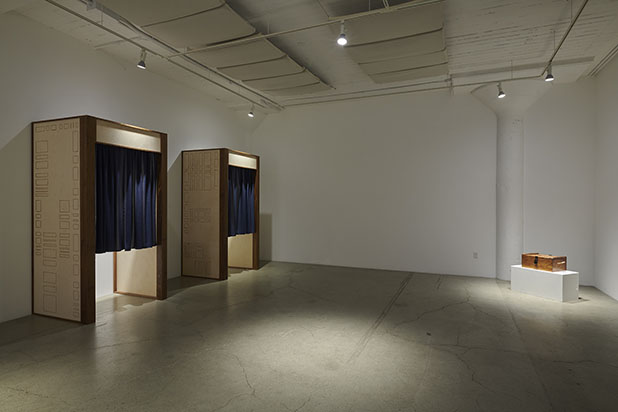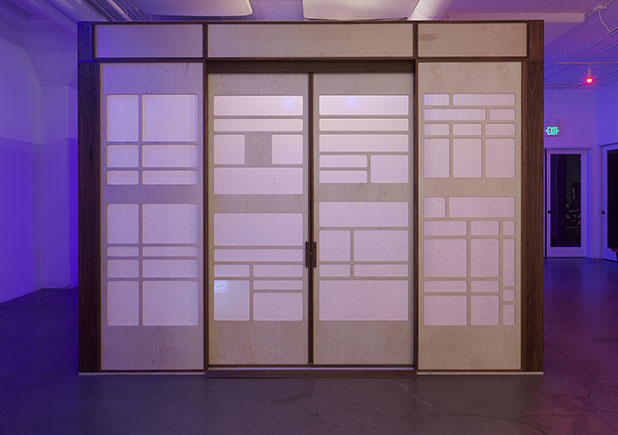“How to Fall in Love in a Brothel” offers a mix of the experiential and the conceptual, expressed as an interactive sculptural installation and an HD video. A collaboration between artists Ellen Sebastian Chang, Sunhui Chang and Maya Gurantz, the idea of a “brothel” takes on a larger definition as an arena where relationships and intimacy may only be possible within the bounds of a culture based on commerce.
The Shoji Room (2019) is a physical manifestation of, and a metaphor for, the idea of intimacy, the full expression—and entrance—only available to those who purchase “Intimacy Hours.” Ritual floor cleaning, cot making and the consumption of corn tea and Hershey’s chocolate are all detailed in the Intimacy Kit (2019). Cell phones are prohibited, the artists curating an experience where a couple interact solely with each other within this small space for sixty minutes, a luxury, or perhaps a challenge.

Ellen Sebastian Chang, Sunhui Chang and Maya Gurantz, (detail) Shoji Room from the installation: How to Fall in Love in A Brothel, 2019. Fabricated by James Anderson. Photo credit: John Wilson White, courtesy Catharine Clark Gallery.
Beautifully constructed of Baltic birch plywood, walnut and Kozo Shoji paper, the room is bathed in hues of red or purple light. Small holes are created in the paper as per the artists’ instructions, allowing viewers to peek into the interior space—referencing a rural tradition in South Korea where newlyweds consummate their marriage in a room with shoji panels, where villagers silently create peepholes in the paper with wetted fingers. Peeping in while a reclined couple whisper together definitely feels transgressive.
The video piece and the entire collaborative project were inspired by a script written by Sunhui Chang in 2017, a fictionalized memoir of his family history in Korea. In it, a couple meets in an abstracted 1950s shoji room, where a girl has prepared food. At one juncture, the young man says “I don’t like the idea of you pleasuring other men.” She replies dryly, “Do you think I cook for just anyone?” A Hershey’s chocolate bar, a type of currency in Korea at the time, provides a moment of rapture.
BOX BLUR programming, in its fourth year at the gallery, extends ideas into performances held within the exhibition. Dance and spoken word performances one evening were by dancer/choreographer DaEun Jung and the multi-disciplinary Maya Gurantz, the latter’s punctuated by impassioned ripping of her clothing as her narrative intensified.
What is most compelling about the exhibition is the way it teases out a response from the viewer, the allure of the forbidden creating desire. The exhibition is also remarkable in its ability to evoke a nostalgic sense of time and place, that of mid-20th century Korea, while simultaneously exploring 21st-century concerns couched in an ironic tone. What, indeed, is the price of privacy?


